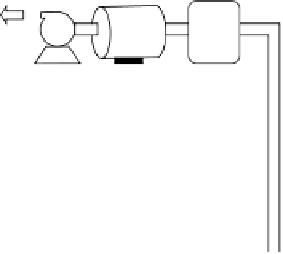Environmental Engineering Reference
In-Depth Information
all the phases in the subsurface. The contaminant will be distributed between pore
air, porewater, solids, and the NAPL phases. The total mass is given by
[A]
g
K
AW
+ ρ
b
K
SA
[A]
g
V
tot
+ ε
N
V
tot
K
NA
[A]
g
, (6.224)
M
tot
= ε
a
V
tot
[A]
g
+ ε
w
V
tot
or concentration by
K
AW
+ ρ
b
K
SA
+ ε
N
K
NA
[A]
g
,
M
tot
V
tot
=
ε
a
+
ε
w
[
A
]
tot
=
(6.225)
where
K
SA
is the soil-air distribution constant for the chemical and
K
NA
is the NAPL-
air distribution constant. Note that
K
SA
=
]
∗
K
AW
)
,
K
SW
/K
AW
and
K
NA
=
ρ
N
/
[
(
A
ρ
N
is the density of the NAPL and [A]
∗
is the aqueous solubility of the
contaminant.
Using the CSTR assumption for the vadose zone between the contaminant source
and the extraction well, we have the following:
where
rate in
=
rate out
+
accumulation (air
+
solid
+
water
+
NAPL).
d
[
A
]
tot
d
t
in
g
Q
g
[
A
]
=
Q
g
[
A
]
g
+
V
tot
.
(6.226)
Since [A]
i
g
0, the resulting differential equation can be solved with the initial
condition that [A]
g
=[
=
A
]
0
at
t
=
0 to obtain
exp
t
.
[
A
]
g
Q
g
R
F
V
tot
]
0
=
−
(6.227)
[
A
Activated
carbon bed
Demister
Air
Blower
Flow
lines
Vadose zone
NAPL
Zone of saturation
FIGURE 6.63
Schematic of a soil vapor stripping well.




















Search WWH ::

Custom Search